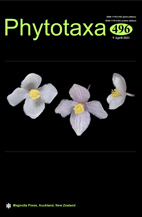Abstract
A new species and its new form, Pluteus hubregtseorum and Pluteus hubregtseorum f. horakianus, are described and illustrated based on material from Australia and New Zealand. Pluteus hubregtseorum is characterized by a squamulose to finely granulose pileus, velutinous at centre and translucently striate at the margin, a pruinose stipe, pileipellis a cutis with transition to a trichoderm, predominantly fusiform to lageniform pleurocystidia and cylindrical to clavate caulocystidia in tufts. Pluteus hubregtseorum f. hubregtseorum has a yellow pileus and a whitish to yellow stipe with distinct floccules, whereas P. hubregtseorum f. horakianus has a brown pileus sometimes darker and radially wrinkled; and a white to cream stipe which becomes tinged yellow-tan or grey-tan near the base with age. The pileipellis structure indicates its placement in the section Hispidoderma, Pluteus plautus group. Multigene phylogenetic analyses of ITS rDNA and EF1-α genes showed Pluteus hubregtseorum is related to P. semibulbosus. Differences of Pluteus hubregtseorum with similar species are also discussed. In addition, Pluteus minor is discussed in detail and as it is not possible to establish a taxon to which it should be unambiguously referred, we reject this dubious name.

